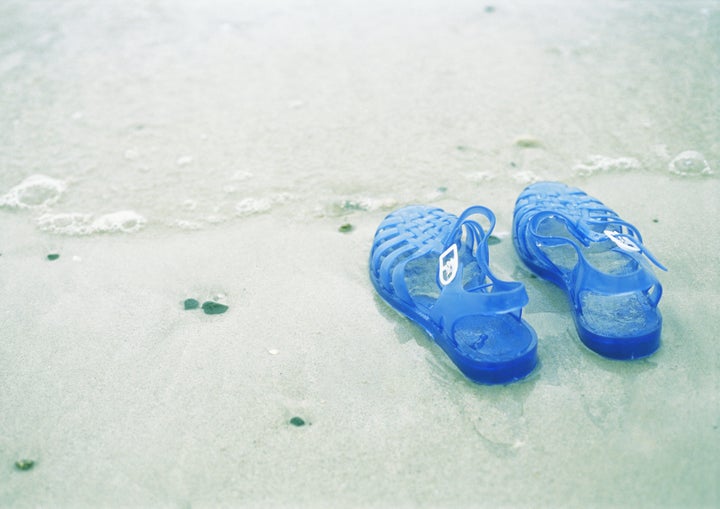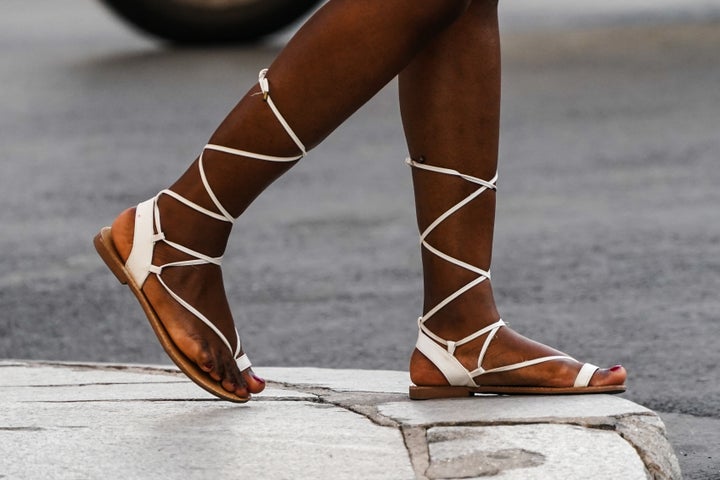Some popular summer shoes can actually lead to foot problems.
When it comes to foot health and shoes, a few things are paramount: proper fit, comfort and support. Unfortunately, many summer shoes are totally flat, so they don’t provide any support for your feet or a comfy platform on which to walk.
Podiatrists say you don’t have to totally give up cute yet unsupportive shoes, but you should limit the amount of time you spend in them — generally, no more than 2 to 3 hours. You should consider the kind of activity you’re doing, too; if you’re going for a long walk, you’ll want to wear sneakers.
And you should be cognizant of the fact that some popular summer shoes can actually lead to foot problems. Which ones? Here’s what podiatrists say:
Jelly Shoes
Dr. Lesly Robinson, the interim associate dean of academic affairs at the Temple University School of Podiatric Medicine in Philadelphia, said her number-one shoe offenders in summer are jelly shoes. Jellies are becoming increasingly popular among not only little kids but adults too, with styles such as heels and sandals.
“Jelly shoes are made of a PVC plastic,” Robinson said. “It’s not a breathable material, so you’ll tend to sweat more in these jelly type of shoes.”
This can make jelly shoes slippery and cause people to fall, she noted.
“Sometimes these jelly shoes … become very hot, so you can have chafing, blisters and the plastic environment of a jelly shoe can lead to foot fungus,” said Robinson.
Jelly shoes aren’t the only popular plastic shoes — Crocs seem to be more and more prevalent every year. Robinson said these can also make your feet sweat because of the material.
Dr. Chandler Hubbard, the clinical director at Western University of Health Sciences’ Foot and Ankle Center in California, said Crocs can be a good shoe to wear in some places, like the house or the garden, but not everywhere.
“I have nothing against [Crocs]; they’re just not the most supportive thing,” said Hubbard. “They’re more like a house shoe to me.”
Flip-Flops That Can Bend And Twist
Plastic flip-flops can be a problem too, with Robinson saying “thin flip-flops that bend and twist” are perhaps best kept to the pool, the beach or hotels.
“If you choose a flip-flop that bends too much and has no arch support, they’re not recommended for casual everyday wear,” Robinson said, since they lack proper support.
These kinds of shoes can cause stress fractures or make you slip and fall, she noted. And flip-flops sometimes “get cracked and frayed, so no matter how much you love them, they can also cause different abrasions on your feet and chafing,” Robinson said.
Meanwhile, the thongs that go between your toes can lead to irritation and blisters, she said.
Robinson noted, however, that you could consider a flip-flop with arch support. Brands like Clarks and FitFlop typically provide more support and stability than plastic, bendy flip-flops that cost only a couple of bucks.
Still, flip-flops with arch support aren’t for everyday use, either.
“I wouldn’t recommend them for longer walks — just for a casual activity,” stated Robinson. “If you’re doing a longer walk or any type of any type of standing or walking greater than … two to three hours, I don’t recommend flip-flops at all.”

Gladiator Sandals
Gladiator sandals are popular summer shoes that wrap around your ankle, but Robinson said they aren’t a proper fit for everyone.
“If you’re prone to ankle swelling, those sandals aren’t good for you,” she stated.
Many folks will slip on a pair of gladiator sandals before evening drinks or dinner plans, but that isn’t ideal, either.
“At the end of the day, that’s when your feet are swollen the most — after gravity, after you walk — that’s when your feet and your ankles are the largest,” Robinson said.
The straps on gladiator sandals can indent your skin and cause abrasions, she added.
For anyone shopping for sandals, Hubbard recommended Birkenstock shoes, which have good arch support, and Vionic sandals.

Any Shoes That Leave Your Heel Exposed
“When you have something when the heel’s out in the back, it’s harder for your foot to grip during walking,” said Robinson, noting that this leads to “repetitive stress of gripping because the shoe lacks structure.”
“You can get an Achilles tendinopathy, which is [pain] in the back of your heel,” Robinson explained. “You can get an ankle sprain because you’re trying to grip and the shoe’s lack of structure makes it more difficult.”
What’s more, flat slip-on shoes don’t have much shock absorption, which can lead to pain at the ball of your foot, she said.
Going Barefoot Is Also Problematic
Summertime may include a quick walk to the mailbox without shoes or a barefoot run on the beach, but Hubbard said walking around like this can lead to a range of foot injuries.
“My biggest thing, especially for the summer, is to tell people not to walk barefoot,” she said. “We don’t want people to step on anything, and we do want to have that support.”
Walking barefoot commonly leads to burns on hot asphalt and other injuries around broken glass, said Hubbard.
“I pick a lot of glass out of people’s feet, unfortunately,” she said.
When Buying Shoes, There Are A Few Important Things To Keep In Mind
“We want something that’s more stiff,” Hubbard said in terms of ideal footwear. “I know soft is usually what people are trying to look for because they want to be comfortable, but a stiffer shoe actually gives more support.”
Stiffer shoes with a rigid arch can help you stay comfortable when running, walking, hiking or just doing errands, Hubbard noted.
“I usually recommend people change their shoes or replace them after about 500 to 1,000 miles of wear,” she said. “That’s kind of hard for people to estimate if they’re not runners and they’re logging everything, but about every six months is reasonable to switch out a pair of sneakers.”
After half a year, the support in sneakers starts to wear down, Hubbard said. (She recommended sneakers from brands like Hoka, ASICS and New Balance.)
When it comes to buying new shoes, Robinson said you should shop later in the day or after exercise, to “make sure your feet feel comfortable when your feet are the largest.”
If you still want to purchase certain shoes even though they might cause foot pain or other issues, that’s OK, too.
“I never tell somebody that they can’t wear a shoe,” Hubbard said. “I tell them wear whatever you want … be comfortable, be cute. Just know that if you’re wearing something that isn’t supportive, that doesn’t have that arch or isn’t stiff, or isn’t meeting the recommendation, you will possibly have some pain.”
For people who don’t have chronic pain or other long-term issues, it’s fine to wear these kinds of shoes — but make sure you don’t do so for long periods of time, or if you plan on running or walking a lot, Robinson said.
“No matter what type of foot you have, or no matter what type of comorbidity or health problem you have, it’s really important to check your feet every day — all sides, the bottoms, in between your toes, just to make sure that you’re not seeing anything that’s new or abnormal,” Hubbard said.
If you notice something concerning, make an appointment to see a podiatrist. “We take for granted being able to walk, and one little thing can change that,” Hubbard said.
Credit: Source link